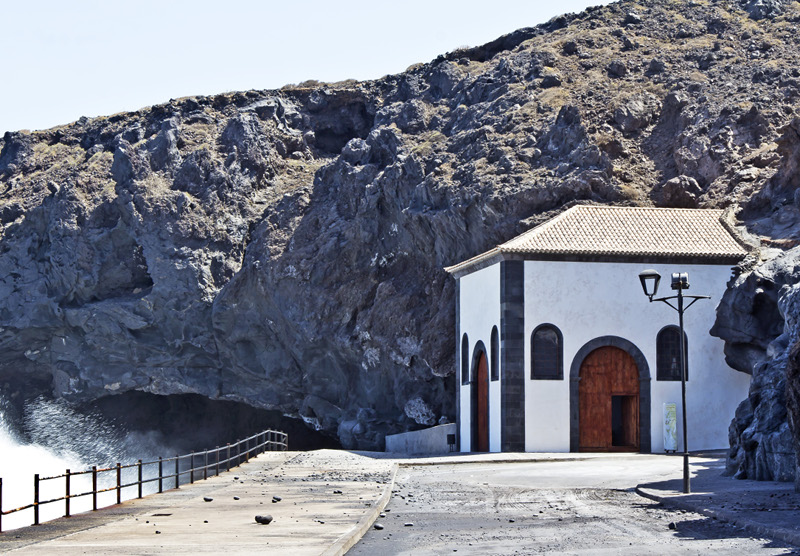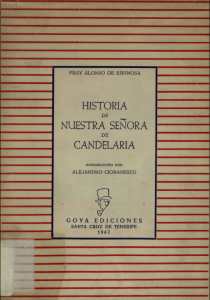This is what on the customs of the natives, with great difficulty and labor, I have could acquire and understand; for them old guanches are so shortsighted and crouched that if they know them, they do not want to tell about them, thinking that divulging them is to lessen their nation.
Brother Alonso de Espinosa (On the origin and miracles of the Holy Statue of Our Lady of Candelaria […] (1594), Book I, Chapter IX – This translation by PROYECTO TARHA)
In the absence of a chronicle specific to the conquest of Tenerife, the work of the Dominican friar Alonso de Espinosa (Alcalá de Henares, 1543 – c. 1600) can be regarded as the first written history on the island of Mount Teide, as well as the second book went to press devoted to the Canary Islands.[1]The first printed book dealing with the Archipelago dates back to 1583 and is titled A Pleasant Description of the Fortunate Ilandes, being its author the English merchantman Thomas Nichols.
Divided into four books published in one volume in 1594 in Seville, On the origin and miracles of the Holy Statue of Our Lady of Candelaria, which appeared on the Isle of Tenerife, with a Description of this Island, it was approached by its author as a research, almost journalistic, work focused on gathering news on the miraculous character of the ancient original statue –disappeared in 1826 though replaced in 2000 by an idealized reproduction cast in bronze– of the Virgin of Candelaria (Virgin of the Candle), supposedly appeared to the Guanches before the beginning of the Royal Conquest of the Archipelago and that had been kept and revered by the indigenes of Tenerife in their shrine inside the Cave of Achbinico, known as San Blas Chapel since its Christianization, behind the current Basilica of Candelaria.[2]Both the original and its recreation, which assumes a medieval Gothic style to its model and stays inside the Cave of Achbinico, barely keep any aesthetic relationship with the best known, neoclassical carving of the nineteenth century, preserved in the Basilica. However, its relevance extends to the field of ethnography, being one of the three most important surviving works on the ancient Guanche culture together with contemporary works of Brother Juan de Abreu Galindo and Leonardo Torriani, because although lacking skills as a true historian and ethnographer, Espinosa shows in this work his special fondness for the ancient Tenerife islanders, probably influenced during his long residence in Guatemala by the indigenous thesis by Brother Bartolomé de las Casas.[3]CIORANESCU (1967), pp. X-XI. Thus, when writing about the different theories that try to explain the origin of the ancient islanders, he claims:
Of these opinions you reader may follow whatever you wish and suits you most; for mine is that they are Africans and bring their offspring from there, either for the nearness of the lands as well as for how much their customs and language do match, so much that counting is the same for all of them. Moreover, their delicacies are the same, as gofio, milk, butter, etc.[4]Op. cit., Book I, Chapter IV.
And on the justification of the Conquest, following the thesis by Father Las Casas, he defends that:
It is a known fact, by divine and human right, that the war that the Spaniards waged against the natives of these islands, as well as against the Indians in the western regions, was unjust, without having any good reason to base it on; because they did not possess Christian lands, nor did they leave their boundaries and limits to infest or disturb those of others. For to say that they brought them the Gospel, it was to be with preaching and admonition, and not with drum and banner, begged and not forced. But this matter has already been dealt with elsewhere.[5]Op. cit., Book III, Chapter V.

Outside the Guanche shrine of the Cave of Achbinico, Christianized as San Blas Chapel, in Candelaria, Tenerife (source: Wikimedia Commons).
The four books cover the following topics:[6]CIORANESCU (1967), pp. XXVIII-XXXII.
- Description of Tenerife and history and ethnography of the Guanche people before the conquest of the Island, obtained from interviews with old indigenes who possibly those years were still living outside the colonial society imposed by the European invaders.
- Origin and appearance of the Virgin of Candelaria, from existing paintings which were accompanied by descriptions about these events.
- The Conquest of Tenerife and the establishment of the new colonial order, plus the history of the statue of the Virgin of Candelaria and the foundation of its monastery.
- Records of fifty-seven miracles allegedly attributed to the Virgin.
The 1594 Seville edition quickly sold out and many of these copies were lost, but fortunately we have a digital copy of it publicly accessible via The Internet Archive. However, although various later editions have been printed, we recommend that of 1967 titled Historia de Nuestra Señora de Candelaria (History of Our Lady of Candelaria), with transcription and introduction by Professor Alejandro Cioranescu.
Antonio M. López Alonso
References
- Espinosa, Fr. A. de. (1594). Del origen y milagros de la Santa Imagen de nuestra Señora de Candelaria, que apareció en la Isla de Tenerife, con la descripción de esta isla. Sevilla: Juan de León.
- Espinosa, Fr. A. de. (1967). Historia de Nuestra Señora de Candelaria. Introducción por Alejandro Cioranescu. Santa Cruz de Tenerife: Goya Ediciones.


2 comments on “The Essentials (VI): History of Our Lady of Candelaria”